Description
Tyrosine Hydroxylase (Phospho-Ser19)Colorimetric Cell-Based ELISA Kit
The Tyrosine Hydroxylase Phospho-Ser19 Colorimetric Cell-Based ELISA Kit is a powerful tool for accurately measuring levels of phosphorylated tyrosine hydroxylase at serine 19 in cell lysates. This kit offers high sensitivity and specificity, allowing for reliable and reproducible results in a variety of research applications.Tyrosine hydroxylase is a key enzyme involved in the biosynthesis of catecholamines, such as dopamine, making it a critical player in neurotransmitter regulation and various neurological disorders. Phosphorylation at serine 19 has been linked to the regulation of tyrosine hydroxylase activity, making it an important biomarker for studying conditions related to dopamine dysregulation.
With the Tyrosine Hydroxylase Phospho-Ser19 Colorimetric Cell-Based ELISA Kit, researchers can gain valuable insights into the phosphorylation status of tyrosine hydroxylase in cell samples, advancing our understanding of neurotransmitter signaling pathways and potentially leading to the development of targeted therapies for neurological conditions.
| Product Name: | Tyrosine Hydroxylase (Phospho-Ser19) Colorimetric Cell-Based ELISA |
| Product Code: | CBCAB01228 |
| ELISA Type: | Cell-Based |
| Target: | Tyrosine Hydroxylase (Phospho-Ser19) |
| Reactivity: | Human, Mouse, Rat |
| Dynamic Range: | > 5000 Cells |
| Detection Method: | Colorimetric 450 nm |
| Format: | 2 x 96-Well Microplates |
The Tyrosine Hydroxylase (Phospho-Ser19) Colorimetric Cell-Based ELISA Kit is a convenient, lysate-free, high throughput and sensitive assay kit that can detect Tyrosine Hydroxylase protein phosphorylation and expression profile in cells. The kit can be used for measuring the relative amounts of phosphorylated Tyrosine Hydroxylase in cultured cells as well as screening for the effects that various treatments, inhibitors (ie. siRNA or chemicals), or activators have on Tyrosine Hydroxylase phosphorylation.
Qualitative determination of Tyrosine Hydroxylase (Phospho-Ser19) concentration is achieved by an indirect ELISA format. In essence, Tyrosine Hydroxylase (Phospho-Ser19) is captured by Tyrosine Hydroxylase (Phospho-Ser19)-specific primary antibodies while the HRP-conjugated secondary antibodies bind the Fc region of the primary antibody. Through this binding, the HRP enzyme conjugated to the secondary antibody can catalyze a colorimetric reaction upon substrate addition. Due to the qualitative nature of the Cell-Based ELISA, multiple normalization methods are needed:
| 1. | A monoclonal antibody specific for human GAPDH is included to serve as an internal positive control in normalizing the target absorbance values. |
| 2. | Following the colorimetric measurement of HRP activity via substrate addition, the Crystal Violet whole-cell staining method may be used to determine cell density. After staining, the results can be analysed by normalizing the absorbance values to cell amounts, by which the plating difference can be adjusted. |
| Database Information: | Gene ID: 7054, UniProt ID: P07101, OMIM: 191290/605407, Unigene: Hs.435609/Hs.523414 |
| Gene Symbol: | TH |
| Sub Type: | Phospho |
| UniProt Protein Function: | TH: an enzyme involved in the conversion of phenylalanine to dopamine. As the rate-limiting enzyme in the synthesis of catecholamines, tyrosine hydroxylase has a key role in the physiology of adrenergic neurons. Four splice variant isoforms have been described. |
| UniProt Protein Details: | Protein type:EC 1.14.16.2; Vesicle; Endoplasmic reticulum; Mitochondrial; Amino Acid Metabolism - tyrosine; Oxidoreductase Chromosomal Location of Human Ortholog: 11p15.5 Cellular Component: synaptic vesicle; internal side of plasma membrane; neuron projection; smooth endoplasmic reticulum; mitochondrion; dendrite; melanosome membrane; cytoplasm; terminal button; perikaryon; cytoplasmic vesicle; cytosol; nucleus Molecular Function:amino acid binding; protein domain specific binding; protein binding; enzyme binding; ferric iron binding; ferrous iron binding; dopamine binding; oxygen binding; tyrosine 3-monooxygenase activity Biological Process: heart morphogenesis; heart development; response to lipopolysaccharide; dopamine biosynthetic process; phytoalexin metabolic process; norepinephrine biosynthetic process; dopamine biosynthetic process from tyrosine; catecholamine biosynthetic process; response to electrical stimulus; epinephrine biosynthetic process; neurotransmitter biosynthetic process; response to pyrethroid; response to corticosterone stimulus; response to light stimulus; anatomical structure morphogenesis; phthalate metabolic process; mating behavior; social behavior; eye photoreceptor cell development; organ morphogenesis; circadian sleep/wake cycle; response to ethanol; response to zinc ion; cerebral cortex development; response to activity; response to water deprivation; synaptic transmission, dopaminergic; response to peptide hormone stimulus; locomotory behavior; fatty acid metabolic process; response to salt stress; regulation of heart contraction; response to estradiol stimulus; sensory perception of sound; visual perception; glycoside metabolic process; response to nutrient levels; terpene metabolic process; sphingolipid metabolic process; eating behavior; response to amphetamine; multicellular organismal aging; isoquinoline alkaloid metabolic process; response to herbicide; learning; response to ether; memory; synaptic vesicle amine transport; pigmentation; response to hypoxia; embryonic camera-type eye morphogenesis Disease: Segawa Syndrome, Autosomal Recessive |
| NCBI Summary: | The protein encoded by this gene is involved in the conversion of tyrosine to dopamine. It is the rate-limiting enzyme in the synthesis of catecholamines, hence plays a key role in the physiology of adrenergic neurons. Mutations in this gene have been associated with autosomal recessive Segawa syndrome. Alternatively spliced transcript variants encoding different isoforms have been noted for this gene. [provided by RefSeq, Jul 2008] |
| UniProt Code: | P07101 |
| NCBI GenInfo Identifier: | 239938945 |
| NCBI Gene ID: | 7054 |
| NCBI Accession: | P07101.5 |
| UniProt Secondary Accession: | P07101,Q0PWM2, Q0PWM3, Q15585, Q15588, Q15589, Q2M3B4 B7ZL70, B7ZL73, |
| UniProt Related Accession: | P07101 |
| Molecular Weight: | 528 |
| NCBI Full Name: | Tyrosine 3-monooxygenase |
| NCBI Synonym Full Names: | tyrosine hydroxylase |
| NCBI Official Symbol: | TH |
| NCBI Official Synonym Symbols: | TYH; DYT14; DYT5b |
| NCBI Protein Information: | tyrosine 3-monooxygenase; dystonia 14; tyrosine 3-hydroxylase |
| UniProt Protein Name: | Tyrosine 3-monooxygenase |
| UniProt Synonym Protein Names: | Tyrosine 3-hydroxylase; TH |
| UniProt Gene Name: | TH |
| UniProt Entry Name: | TY3H_HUMAN |
| Component | Quantity |
| 96-Well Cell Culture Clear-Bottom Microplate | 2 plates |
| 10X TBS | 24 mL |
| Quenching Buffer | 24 mL |
| Blocking Buffer | 50 mL |
| 15X Wash Buffer | 50 mL |
| Primary Antibody Diluent | 12 mL |
| 100x Anti-Phospho Target Antibody | 60 µL |
| 100x Anti-Target Antibody | 60 µL |
| Anti-GAPDH Antibody | 60 µL |
| HRP-Conjugated Anti-Rabbit IgG Antibody | 12 mL |
| HRP-Conjugated Anti-Mouse IgG Antibody | 12 mL |
| SDS Solution | 12 mL |
| Stop Solution | 24 mL |
| Ready-to-Use Substrate | 12 mL |
| Crystal Violet Solution | 12 mL |
| Adhesive Plate Seals | 2 seals |
The following materials and/or equipment are NOT provided in this kit but are necessary to successfully conduct the experiment:
- Microplate reader able to measure absorbance at 450 nm and/or 595 nm for Crystal Violet Cell Staining (Optional)
- Micropipettes with capability of measuring volumes ranging from 1 µL to 1 ml
- 37% formaldehyde (Sigma Cat# F-8775) or formaldehyde from other sources
- Squirt bottle, manifold dispenser, multichannel pipette reservoir or automated microplate washer
- Graph paper or computer software capable of generating or displaying logarithmic functions
- Absorbent papers or vacuum aspirator
- Test tubes or microfuge tubes capable of storing ≥1 ml
- Poly-L-Lysine (Sigma Cat# P4832 for suspension cells)
- Orbital shaker (optional)
- Deionized or sterile water
*Note: Protocols are specific to each batch/lot. For the correct instructions please follow the protocol included in your kit.
| Step | Procedure |
| 1. | Seed 200 µL of 20,000 adherent cells in culture medium in each well of a 96-well plate. The plates included in the kit are sterile and treated for cell culture. For suspension cells and loosely attached cells, coat the plates with 100 µL of 10 µg/ml Poly-L-Lysine (not included) to each well of a 96-well plate for 30 minutes at 37°C prior to adding cells. |
| 2. | Incubate the cells for overnight at 37°C, 5% CO2. |
| 3. | Treat the cells as desired. |
| 4. | Remove the cell culture medium and rinse with 200 µL of 1x TBS, twice. |
| 5. | Fix the cells by incubating with 100 µL of Fixing Solution for 20 minutes at room temperature. The 4% formaldehyde is used for adherent cells and 8% formaldehyde is used for suspension cells and loosely attached cells. |
| 6. | Remove the Fixing Solution and wash the plate 3 times with 200 µL 1x Wash Buffer for five minutes each time with gentle shaking on the orbital shaker. The plate can be stored at 4°C for a week. |
| 7. | Add 100 µL of Quenching Buffer and incubate for 20 minutes at room temperature. |
| 8. | Wash the plate 3 times with 1x Wash Buffer for 5 minutes each time. |
| 9. | Add 200 µL of Blocking Buffer and incubate for 1 hour at room temperature. |
| 10. | Wash 3 times with 200 µL of 1x Wash Buffer for 5 minutes each time. |
| 11. | Add 50 µL of 1x primary antibodies Anti-Tyrosine Hydroxylase (Phospho-Ser19) Antibody, Anti-Tyrosine Hydroxylase Antibody and/or Anti-GAPDH Antibody) to the corresponding wells, cover with Parafilm and incubate for 16 hours (overnight) at 4°C. If the target expression is known to be high, incubate for 2 hours at room temperature. |
| 12. | Wash 3 times with 200 µL of 1x Wash Buffer for 5 minutes each time. |
| 13. | Add 50 µL of 1x secondary antibodies (HRP-Conjugated AntiRabbit IgG Antibody or HRP-Conjugated Anti-Mouse IgG Antibody) to corresponding wells and incubate for 1.5 hours at room temperature. |
| 14. | Wash 3 times with 200 µL of 1x Wash Buffer for 5 minutes each time. |
| 15. | Add 50 µL of Ready-to-Use Substrate to each well and incubate for 30 minutes at room temperature in the dark. |
| 16. | Add 50 µL of Stop Solution to each well and read OD at 450 nm immediately using the microplate reader. |
(Additional Crystal Violet staining may be performed if desired – details of this may be found in the kit technical manual.)






